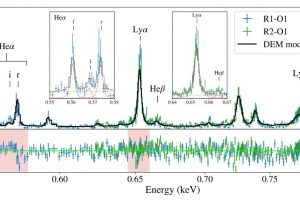X-rays from SN1987A: shocks, circumstellar clouds and ionised oxygen described in two recent publications

Analysis of X-ray observations of the SN1987A supernova remnant, obtained by the XMM-Newton satellite, provides new insights into the interaction between the supernova shock wave and the circumstellar material, as well as the oxygen abundance in the remnant.
The SN1987A supernova remnant is undoubtedly one of the most iconic objects for studying supernovae, their remnants, and the final stages of massive stellar evolution. It exploded in 1987 in the Large Magellanic Cloud, originating from a blue supergiant star, and represents the closest observed supernova in modern times. It is the only case where we have multi-wavelength and multi-messenger observations (including neutrino detection) of the progenitor star, the supernova explosion, and the resulting remnant. The remnant is continuously monitored across the entire electromagnetic spectrum to follow its evolution and understand the complex physical processes occurring within it.
In particular, X-ray observations allow researchers to study high-energy processes taking place in the remnant and to derive the physical properties of million-degree plasma and highly ionized chemical elements.
X-ray emission from SN1987A has been monitored over the years by the European Space Agency XMM-Newton satellite. The analysis of these data is the subject of two publications led by astrophysicist Sun Lei from Nanjing University.
The first study, titled “Evolution of X-Ray Gas in SN 1987A from 2007 to 2021: Ring Fading and Ejecta Brightening Unveiled through Differential Emission Measure Analysis”, presents a detailed analysis of observations taken between 2007 and 2021. In particular, the authors examined the temporal variation of the X-ray emission measure, a quantity related to the amount of high-temperature plasma responsible for the X-ray radiation. They found a peak emission from plasma with temperatures between about 5 and 12 million degrees, with an additional contribution from plasma exceeding 58 million degrees. This emission peak shifted to progressively higher temperatures between 2011 and 2014, corresponding to the impact of the supernova shock wave with a ring of circumstellar material previously expelled by the progenitor. The intenstiy of this emission peak decreased as the forward shock left the equatorial ring. However, in the meantime a secondary peak due to emission from 30-60 million degrees plasma rised. This secondary peak is of great importance, being emitted by the fragments of the progenitor ejected by the supernova, and compressed and heated by the reverse shocks, which develop as a consequence of the interaction between the forward shock and the circumstellar material. This emission has been suggested by theoretical models, but never observed so far.
The second study, titled “Unusual X-Ray Oxygen Line Ratios of SN 1987A Arising from the Absorption of Galactic Hot Interstellar Medium”, presents a spectroscopic analysis of the X-ray emission from ionized oxygen atoms retaining one or two electrons (i.e., in hydrogen-like or helium-like states). The observed signals appear to be affected by the absorption of X-rays by the diffuse, hot plasma that fills the Milky Way’s halo. Taking this absorption into account, the oxygen abundance in the supernova remnant is estimated to be about 20% higher than previous measurements.
Both articles were published in The Astrophysical Journal, with contributions from astrophysicists S. Orlando and E. Greco from INAF – Palermo Astronomical Observatory and M. Miceli from the University of Palermo.
The cover image (click here to view in full) shows the portion of the spectrum containing the oxygen lines analyzed in the study, particularly those highlighted in the boxes. The crosses indicate the observed data points, while the various line types represent the models used to study these lines and to determine the chemical and physical properties of the plasma.
Mario Giuseppe Guarcello
Follow MarioSpiegaCose on Instagram () , Facebook (), Youtube (), and X ()
Follow the Astronomical Observatory of Palermo on Facebok and on Instagram
Subscribe the Youtube channel of the Astronomical Observatory of Palermo
